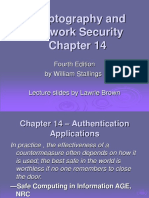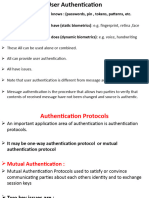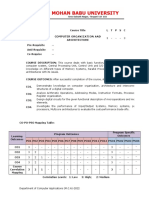Prepaid Call Flow
Prepaid Call Flow
Uploaded by
Raj KamCopyright:
Available Formats
Prepaid Call Flow
Prepaid Call Flow
Uploaded by
Raj KamCopyright
Available Formats
Share this document
Did you find this document useful?
Is this content inappropriate?
Copyright:
Available Formats
Prepaid Call Flow
Prepaid Call Flow
Uploaded by
Raj KamCopyright:
Available Formats
Show << >>
Call Flow Specifications
Pre-paid Calling Card - Call Flow (with default language) Figure 22 is a diagram of the call flow for pre-paid calling card service, which details the messages transmitted between the following components: Calling Party. The originating caller using a pre-paid calling card. Prepaid Enabled Tenor. The Tenor performing the IVR functions. RADIUS Server. Remote Authentication Dial-In User Service for authenticating and authorizing user access to the VoIP network. The RADIUS provides a series of standardized messages formats for transmitting and receiving dialed information, account data and authorization codes between the network access gateway and the billing server. Called Party. The destination called party. Figure 22 Pre-paid Calling Card - Call Flow (default language)
Post-paid Calling Card - Call Flow (with default language)
Figure 23 is a diagram of the call flow for post-paid service, which details the messages transmitted between the following components: Calling Party. The originating caller using a post-paid calling party. Postpaid Enabled Tenor. The Tenor performing the IVR functions. RADIUS Server. Remote Authentication Dial-In User Service for authenticating and authorizing user access to the VoIP network. The RADIUS provides a series of standardized message formats for transmitting and receiving dialed information, account data and authorization codes between the network access gateway and the billing server. Called Party. The destination called party. Figure 23 Post-paid Account - Call Flow (default language)
Pre-paid and Post-paid Calling Card - Call Flow (with multiple language support) Figure 24 is a diagram of the call flow for pre-paid calling card service, which details the messages transmitted between the following components: Calling Party. The originating caller using a pre-paid calling card. Tenor. The Tenor performing the IVR functions. RADIUS Server. Remote Authentication Dial-In User Service for authenticating and authorizing user access to the VoIP network. The RADIUS provides a series
of standardized messages formats for transmitting and receiving dialed information, account data and authorization codes between the network access gateway and the billing server. Called Party. The destination called party. Figure 24 Pre-paid and Post-paid Calling Card - Call Flow (multiple language support)
Pre-paid and Post-paid Calling Card - Call Flow (with Multi-Session Call support) For a multi-session call, the calling party can interrupt the call by pressing a multisession key at anytime and making a new call. When the called party disconnects the call first, the Tenor asks if the caller wants another call; the user can then press the designated key. Figure 5 is a diagram of the call flow for pre-paid and post-paid call card service (with multi-session support), which details the messages transmitted between the following components: Calling Party. The originating caller using a pre-paid calling card. Tenor. The Tenor performing the IVR functions. RADIUS Server. Remote Authentication Dial-In User Service for authenticating and authorizing user access to the VoIP network. The RADIUS provides a series of standardized messages formats for transmitting and receiving dialed information, account data and authorization codes between the network access gateway and the billing server. Called Party 1. The first destination called party. Called Party 2. The second destination called party.
Figure 25 Pre-paid and Post-paid Calling Card - Call Flow (multi-session support)
ANI Authentication Application Type 1 - Call Flow ANI Authentication Application Type 1 enables calling subscribers to receive authentication based on the calling number. If you configure the ivrtype to 4 (ANI Type 1), when an incoming call comes in, the call will be authenticated with ANI by a RADIUS server. Figure 26 is a diagram of the call flow for ANI Authentication Application Type 1, which details the messages transmitted between the following components: Calling Party. The originating caller using a pre-paid calling card. ANI AUTH Enabled Tenor. The Tenor which enables the ANI authentication functions. RADIUS Server. Remote Authentication Dial-In User Service for authenticating with ANI the calling number. Called Party. The destination called party. Figure 26 ANI Authentication Application Type 1 - Call Flow
ANI Authentication Application Type 2 - Call Flow ANI Authentication Application Type 2 enables calling subscribers to receive three authentication types based on the calling number: Authentication with ANI No ANI case (if no ANI in coming packet, Tenor asks PIN number by prompt) Incoming packet has the ANI, but authentication with the ANI fails and Tenor prompts for the PIN number. Figure 27 is a diagram of the call flow for ANI Authentication Application Type 2, which details the messages transmitted between the following components: Calling Party. The originating caller using a pre-paid calling card. ANI AUTH Enabled Tenor. The Tenor which enables the ANI authentication functions. RADIUS Server. Remote Authentication Dial-In User Service for authenticating with ANI the calling number. Called Party. The destination called party. Figure 27 ANI Authentication Application Type 2 - Call Flow
You might also like
- AgreementDocument4 pagesAgreementmastermind_asia938950% (2)
- Sounding Better! Helpful Hints To Troubleshoot HYPACK: Q 1: Hypack® O E G ODocument3 pagesSounding Better! Helpful Hints To Troubleshoot HYPACK: Q 1: Hypack® O E G OSiva RamanNo ratings yet
- RFP 12162016-CCaaSDocument104 pagesRFP 12162016-CCaaSPhuong VuNo ratings yet
- DTC Service Agreement Number:: (Private & Confidential)Document20 pagesDTC Service Agreement Number:: (Private & Confidential)Miguel Goncalves100% (4)
- CTR 8500-8300 3.5.20 TLM CLI Commands - January2018Document36 pagesCTR 8500-8300 3.5.20 TLM CLI Commands - January2018Sandra Milena ViracachaNo ratings yet
- Call Spoofing Services, Modus Operandi, Regulatory Framework and Impact On SocietyDocument9 pagesCall Spoofing Services, Modus Operandi, Regulatory Framework and Impact On SocietyHarish KumarNo ratings yet
- Information System Security AABFS-Jordan: Supervisor:Dr. Lo'ai Ali TawalbehDocument18 pagesInformation System Security AABFS-Jordan: Supervisor:Dr. Lo'ai Ali TawalbehRoyNo ratings yet
- EWSD Based IN Services in Transit Network Nodes (TXS Services)Document9 pagesEWSD Based IN Services in Transit Network Nodes (TXS Services)Eugen BleulerNo ratings yet
- ch4 Bu CnsDocument80 pagesch4 Bu CnsSudhanshu PandeyNo ratings yet
- OTP For Banks From ViSolveDocument5 pagesOTP For Banks From ViSolveGoran ZdravkovNo ratings yet
- 09-Voice RADIUS ConfigurationDocument25 pages09-Voice RADIUS Configurationmattscott867No ratings yet
- UMS Banking Gateway-Direct-Post-APIDocument46 pagesUMS Banking Gateway-Direct-Post-APIabsdulNo ratings yet
- Numbering Plan For Internet TelephonyDocument4 pagesNumbering Plan For Internet TelephonySuraj JoshiNo ratings yet
- Telecom Call FlowDocument75 pagesTelecom Call FlowVikas Sinha100% (1)
- SIP IntroductionDocument7 pagesSIP IntroductionkflimNo ratings yet
- CNS UNIT 4 - CompressedDocument31 pagesCNS UNIT 4 - CompressedDinesh BE CSENo ratings yet
- SIP DocumentDocument25 pagesSIP DocumentballavNo ratings yet
- 3D SECURE V2 Manual Ver 1.0.5 ENDocument47 pages3D SECURE V2 Manual Ver 1.0.5 ENGiorgos GrivokostopoulosNo ratings yet
- Updated Product_Paper_Instant Bills Pay - with supplier Payment FeaturesDocument5 pagesUpdated Product_Paper_Instant Bills Pay - with supplier Payment Featurespaulinmbami1No ratings yet
- CNS Unit IV PDFDocument80 pagesCNS Unit IV PDFKartheeNo ratings yet
- API ProcessDocument25 pagesAPI ProcessAbhishek RanjanNo ratings yet
- Apuntes H.323 - SIPDocument6 pagesApuntes H.323 - SIPDavid Augusto MoreiraNo ratings yet
- Public Key Infrastructure (PKI)Document23 pagesPublic Key Infrastructure (PKI)RohFollowerNo ratings yet
- Kerberos X509Document31 pagesKerberos X509GeorgeStenNo ratings yet
- Management and Security of Telecommunication Networks: Authentication ApplicationsDocument25 pagesManagement and Security of Telecommunication Networks: Authentication ApplicationsZeeshan Afzal AwanNo ratings yet
- CNS-III & IV-0-Kereberos-firewallsDocument59 pagesCNS-III & IV-0-Kereberos-firewallsrxbunnyNo ratings yet
- En GVP 9.0.x GDG AGCFDocument16 pagesEn GVP 9.0.x GDG AGCFAndriy ZatyshnyyNo ratings yet
- HTTP - Intouchpay - Api - Ver 1.2Document12 pagesHTTP - Intouchpay - Api - Ver 1.2Patrick YagiNo ratings yet
- 206AB Internal DocumentationDocument4 pages206AB Internal DocumentationAkshat GhiyaNo ratings yet
- BASIC CONCEPTS Static Web PagesDocument196 pagesBASIC CONCEPTS Static Web PagesJayesh ShindeNo ratings yet
- CH 14Document26 pagesCH 14hemashekhawat1994007No ratings yet
- Approach Document Power EcollDocument11 pagesApproach Document Power EcollavashborahNo ratings yet
- Protocols Used in VoipDocument9 pagesProtocols Used in VoipkapeedagancNo ratings yet
- Cryptography and Network Security: Fourth Edition by William StallingsDocument33 pagesCryptography and Network Security: Fourth Edition by William Stallingsprudhvi chowdaryNo ratings yet
- Fourth Edition by William StallingsDocument26 pagesFourth Edition by William Stallingskstu1112No ratings yet
- INS unit 2Document57 pagesINS unit 2zenostt06No ratings yet
- Call Flow Specification For Contact Center and CRM IntegrationDocument3 pagesCall Flow Specification For Contact Center and CRM IntegrationAmit AggarwalNo ratings yet
- Credit Cards SO APIDocument403 pagesCredit Cards SO APIyadbhavishyaNo ratings yet
- INgfgDocument32 pagesINgfgJason RogersNo ratings yet
- Integrate Payments Direct Post APIDocument31 pagesIntegrate Payments Direct Post APIAnjali SharmaNo ratings yet
- SwiftDocument54 pagesSwiftYogesh Kumar100% (1)
- Microtalk-End User Portal (Call Center) - Aug-07-2023-07-49-50-6182-AMDocument19 pagesMicrotalk-End User Portal (Call Center) - Aug-07-2023-07-49-50-6182-AMsales.bellmarketingNo ratings yet
- Prepaid Card Service: Benefits ... For The OperatorDocument5 pagesPrepaid Card Service: Benefits ... For The OperatorEugen BleulerNo ratings yet
- Introduction:: UNIT-4Document25 pagesIntroduction:: UNIT-4shiva guntiNo ratings yet
- Obtaining A User's CertificateDocument4 pagesObtaining A User's CertificateAshwin ThenappanNo ratings yet
- Security+ Guide To Network Security Fundamentals, Fifth EditionDocument67 pagesSecurity+ Guide To Network Security Fundamentals, Fifth EditionutgotyeNo ratings yet
- Knowlarity SR Integration Guide Jan 2013 2Document8 pagesKnowlarity SR Integration Guide Jan 2013 2srikanthNo ratings yet
- Is Unit 3 PPT - Part 2Document32 pagesIs Unit 3 PPT - Part 2sheikh Riyaz ul haqNo ratings yet
- Web Security: Course: Network Security by DR Adnan NadeemDocument37 pagesWeb Security: Course: Network Security by DR Adnan NadeemKatherine GenailNo ratings yet
- Authentication ServicesDocument23 pagesAuthentication Servicessr23shubhiNo ratings yet
- Web Security: Secure Socket Layer (SSL)Document6 pagesWeb Security: Secure Socket Layer (SSL)Lokesh Sai Kumar DasariNo ratings yet
- Analog/Isdn/Geocentrex: Malicious Call Identification (Mci)Document8 pagesAnalog/Isdn/Geocentrex: Malicious Call Identification (Mci)Eugen BleulerNo ratings yet
- Lecture 5 (SET)Document20 pagesLecture 5 (SET)kwaheedNo ratings yet
- Business Requirements Document - WebsiteDocument4 pagesBusiness Requirements Document - Websitebeautiful111No ratings yet
- APC Agent Blending Configuration DocumentDocument55 pagesAPC Agent Blending Configuration DocumentMrinal ManharNo ratings yet
- Access Levels in Visa Clarity: Member Project Requestor: Least One User Set-Up As A Member Approver. If Not, ThenDocument10 pagesAccess Levels in Visa Clarity: Member Project Requestor: Least One User Set-Up As A Member Approver. If Not, ThenEmi BaditoiuNo ratings yet
- 1 Auth Appli, KerberosDocument45 pages1 Auth Appli, KerberosnvkeerthuvcetNo ratings yet
- Module 2Document31 pagesModule 2vvce21cse0148No ratings yet
- SwiftDocument96 pagesSwiftPushkar Anand100% (1)
- SS7 ISUP ParametersDocument5 pagesSS7 ISUP ParametersraufthegreatNo ratings yet
- Credit Card Protocols/ Web Security: SSL, SetDocument20 pagesCredit Card Protocols/ Web Security: SSL, SetAmogh S MirashiNo ratings yet
- Evaluation of Some Websites that Offer Remote Desktop Protocol (RDP) Services, Virtual Phone Numbers for SMS Reception and Virtual Debit/Credit CardsFrom EverandEvaluation of Some Websites that Offer Remote Desktop Protocol (RDP) Services, Virtual Phone Numbers for SMS Reception and Virtual Debit/Credit CardsNo ratings yet
- Innbox g31Document2 pagesInnbox g31apelei9563No ratings yet
- Ubuntu Server GuideDocument413 pagesUbuntu Server GuideISAI VARGASNo ratings yet
- Computer ConnectionsDocument48 pagesComputer ConnectionsIbrahim AnwarNo ratings yet
- exSILentia User GuideDocument292 pagesexSILentia User GuideANo ratings yet
- Beamng DxdiagDocument40 pagesBeamng DxdiagAndrei GrosuNo ratings yet
- 22CA201002 Computer Organization and ArchitectureDocument3 pages22CA201002 Computer Organization and ArchitectureBhumireddy ChandanaNo ratings yet
- Which of The Following Persons Invented The Punch Card MachineDocument4 pagesWhich of The Following Persons Invented The Punch Card Machineara.ict2024No ratings yet
- (How-To) Root G900AUCU2ANG3 - AT&T Samsung Galaxy S 5Document8 pages(How-To) Root G900AUCU2ANG3 - AT&T Samsung Galaxy S 5Adrián BuenoNo ratings yet
- Untuk Spesifikasi Silahkan Cek Melalui Website Resmi Dari Merk TersebutDocument31 pagesUntuk Spesifikasi Silahkan Cek Melalui Website Resmi Dari Merk TersebutajusberryNo ratings yet
- ST Thomas School Question For ComputerDocument2 pagesST Thomas School Question For ComputerLionelkeneth12No ratings yet
- 10 D CS Paper 1Document14 pages10 D CS Paper 1Min Swan PyaeNo ratings yet
- CPNMC Comp22Document6 pagesCPNMC Comp22Sharan RaoNo ratings yet
- Amazon AppStream 2.0 - SAP GUI Deployment GuideDocument51 pagesAmazon AppStream 2.0 - SAP GUI Deployment Guidebalamurali_aNo ratings yet
- DekTec DTE-3137Document7 pagesDekTec DTE-3137Alexander WieseNo ratings yet
- Maestro ASi IFMDocument280 pagesMaestro ASi IFMmanicomicNo ratings yet
- Resource Management: IB Computer ScienceDocument8 pagesResource Management: IB Computer ScienceKaran ShahNo ratings yet
- MC5501 Cloud ComputingDocument24 pagesMC5501 Cloud Computingsajithabanu banuNo ratings yet
- Adams Drive ManualDocument10 pagesAdams Drive ManualKabilan MuthukannanNo ratings yet
- Sample of ClouddDocument36 pagesSample of ClouddLuis GonzalezNo ratings yet
- Ch341a Mini Flash ProgrammerDocument5 pagesCh341a Mini Flash ProgrammerendreminarikNo ratings yet
- EcoStruxure Condition Advisor Guide - B0750cu - DDocument72 pagesEcoStruxure Condition Advisor Guide - B0750cu - DjeffNo ratings yet
- ZERO Lecture CSE316 Jan - April 2024Document39 pagesZERO Lecture CSE316 Jan - April 2024what90642No ratings yet
- IBM Mainframe COBOL DB2 JCL CICS TutorialsDocument21 pagesIBM Mainframe COBOL DB2 JCL CICS TutorialstpillaiNo ratings yet
- M-VCI ESI 2.0 SFP Installation Guide 0412Document28 pagesM-VCI ESI 2.0 SFP Installation Guide 0412Ilarion CiobanuNo ratings yet
- Puppet Interview QuestionsDocument5 pagesPuppet Interview QuestionsAmitha R HNo ratings yet
- Computer Architecture Organization - Unit-2Document18 pagesComputer Architecture Organization - Unit-2aayushgithala101No ratings yet
- MCC7500 Initial Setting Procedure (April 2022)Document3 pagesMCC7500 Initial Setting Procedure (April 2022)Max KomarovNo ratings yet
- IVMS-4200 v2.5.0.5 Release NotesDocument7 pagesIVMS-4200 v2.5.0.5 Release NotesjoviunicoNo ratings yet

























































































